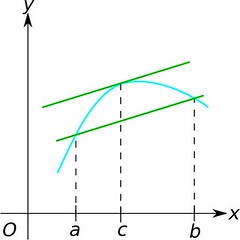If f(x) is continuous on [a, b] and differentiable on (a, b), then there is a c in (a, b) such that
f'(c)= [f(b)-f(a)]/(b-a)
它的幾何意義,就是說出若 y=f(x) 是區間 [a,b] 上的一條圓滑曲線,則存在一點 (c, f(c)),在該點上的切線斜率會等於連接 (a, f(a)) 和 (b, f(b))的直線斜率。

此外,還學了一個叫 General mean value theorem:
If f(x) and g(x) are continuous on [a, b] and differentiable on (a, b), then there is a c in (a, b) such that
f'(c)[g(b)-g(a)] = g'(c)[f(b)-f(a)]
幾年來,我一直也想不出它的幾何意義,證明時又要砌多一個函數來搞。
近日看了一些幾何書籍,搞幾何時多數不會用 y=f(x) 的形式去表示曲線方程,而是用參數式 ( x(t), y(t) ) 來表示。
用參數式去看 mean value theorem 的幾何意義,所得的數式不就是 general mean value theorm 的形式嗎?
大一 calculus 已是多年前的事,現今才知道這個意義,看來我真是無乜料。
人又不夠勤力吧。想出這個意義後,我上 wiki 到看看,原來也有記述這個詮釋。勤力d睇多幾本書,或者我已經一早知道。
遲就遲d,但自己親手解決多年的疑惑,是一件十分喜悅的事情。
1 comment:
Thank you. Although I forget if I have thought of this interpretation of the generalized mean value theorem when I saw it many years ago, your interpretation is definite a good one.
Post a Comment